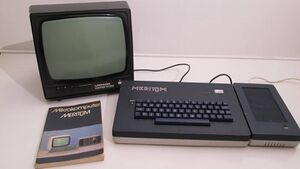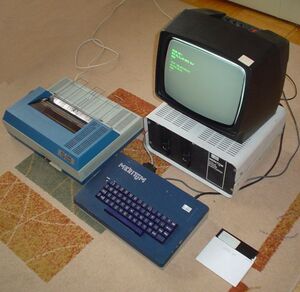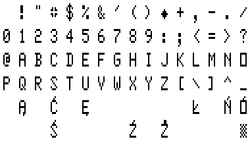Engineering:Mera-Elzab Meritum
Mera–Elzab Meritum – a family[1] of Poland personal computers based on TRS-80 Model I with BASIC Level II.[2][3][4][5][6] Manufactured in the 1980s by Mera–Elzab in cooperation with ITM company.[2][7][8][9]
History
In the late 1970s and early 1980s, there was no small microcomputer available for the general public in Poland.[8] The Polish computer industry was manufacturing only mainframe systems but not small computers for personal use.
In the 1980s, Mera–Elzab was in the group of 500 largest Polish industrial enterprises and 100 largest exporters. It produced terminals, monitors, and computers, but did not manufacture products for the mass consumer market.[10]
ITM was a small foreign company operating in Poland selling measuring systems. In Poland under the rule of the communists, all companies (including Mera–Elzab) were state-owned. One exception was the companies owned by foreigners, often Polish emigrants.
Design of the Meritum began in 1982.[11] It was a time of major economic crisis and martial law in Poland. Mera–Elzab analyzed existing western small computer systems and the following aspects were taken into account for a new product:[3]
- System components: processor, peripheral and memory chips must be available in Poland or Comecon.
- TV or a cheap monitor as a display.
- The software in ROM memory.
- Tape recorder as mass storage.
- Possibility to connect existing peripherals (printer, punch tape reader).
Based on the above assumptions, TRS Model I with BASIC Level II was selected. It was a computer using a Zilog Z80 processor that could be replaced by the U880 made in East Germany. Peripheral chips produced in Poland by CEMI factory for the MCY7880 processor (Intel 8080 clone) could be used for both the Z80 and U880. Memory chips were available in the Soviet Union.[4]
The company expected that due to the price the computer would not be available for individual users. Small businesses were the primary target market, followed by research and education institutions. They expected the computer would be also used as an industrial controller.[2]
The fathers of the computer were Zygmunt Korga, later technical director of Mera–Elzab and Paweł Podsiadło, an employee of ITM company.[10] They were friends from the time of study at the Silesian University of Technology.
The computer was presented to the public for the first time at the Poznań International Fair in the autumn of 1983. Production began in the summer of 1984. Preparation for production cost 10 million PLZ[11] which was relatively cheap.
From 1984 to 1986 Mera–Elzab produced 2,500 units.[11] The maximum production capacity of the plant was 4000 units per year.[8] The computer was assembled in one room, where 5 people worked. Production of one computer consumed 20 man–hours.[11] The computer accounted for 1%[8][11] of the production value and at the best moment no more than 3%.[10]
In 1986 Mera–Elzab sold the licence to Elwro company and terminated production.[11][12] In 1987 Elwro finished production of Meritum as it started manufacturing its personal computer for schools Elwro 800 Junior.[12]
The reception of the computer was initially positive, it was seen as the first polish personal computer. Later opinions tend to be critical. The press pointed out technical specification is not impressive, especially lack of graphic mode.[8][10] Besides, TRS-80 was an unknown computer in Poland.[10] There was no software or technical documentation on the market.[10]
The computer never became popular, mostly because of a low number of units produced,[11] the price and technical specification were not competitive to other products,[8] and lack of software and documentation.[13]
Comparison with other computers
Free market prices in 1986. The average salary in that year was 24,095 PLZ.[14]
| Computer | Price PLZ | Release | RAM KiB | Text mode | Graphics mode | Sound channels |
|---|---|---|---|---|---|---|
| Meritum I | 103,000[11] | 1983 | 48 | 64×16 | 128×48 | 1 |
| ZX81 | 35,000[15] | 1981 | 1+16 | 32×24 | 64×48 | 0 |
| ZX Spectrum | 120,000[15] | 1982 | 48 | 32×24 | 256×192 | 1 |
| Atari 800XL | 95,000[15] | 1983 | 64 | 40×24 | 320×192 | 4 |
| Commodore 64 | 175,000[15] | 1982 | 64 | 40×25 | 320×200 | 3 |
Meritum I
 Meritum I with monitor. Box on the right is power supply. | |
| Type | Personal computer |
|---|---|
| Release date | 1983 |
| Operating system | TRS-80 Model I BASIC Level II |
| CPU | U880 @ 2.5 MHz |
| Memory | 16 or 17KB |
| Removable storage | Cassette Tape |
| Display | Composite video, 64×16, 32×16 text; 128×48 semigraphics; monochrome |
| Sound | Intel 8253, 1 channel |
Based on U880 processor at 2.5 MHz. 17 KiB[2] of RAM (16 KiB of dynamic memory[4] and 1 KiB static memory[4]); 16 KiB version was also available.[7]

MEMORY SIZE as ROZMIAR PAO.14 KiB of ROM[5][2] consisted of 12 KiB BASIC. It was slightly modified TRS-80 Model I BASIC Level II. In additional 2 KiB, monitor program was stored.[5] Content of ROM was provided by ITM company.
Display circuit was similar to TRS-80, it supported 64×16 or 32×16 monochrome text mode[5][2] only; low resolution 128×48 graphic mode simulated by semigraphics.[5] Character generator resided in separate ROM memory, there was also separate 1 KiB of video memory.[5] Similar to TRS-80 there were no lower case characters.[1] No polish specific characters (ĄĘĆŚÓŃŁŻŹ) on the keyboard and character table.[1]
Composite video signal available on standard DIN socket. Due to the lack of a built-in TV modulator, it was not possible to connect directly to the TV.[4][5] An external TV adapter working in channels 1–6 was available.[5]
The computer was equipped with parallel and serial port not compatible with TRS-80 Expansion Interface.
Parallel port was based on MCY7855 universal I/O chip which was Polish clone of Intel 8255.[5] It could be used to control industrial processes or other pheripherials. Although Centronics printer may be connected, there was no software support for that option in ROM.
Serial port used MCY7851 (clone of Intel 8251); transmission rates from 95 to 9600 bauds were possible.[5]
In addition, hardware counter chip 8253 was available. Thanks to this chip the computer could generate sound (1 channel), initially using built-in speaker later using an amplifier in a monitor.
As mass storage, only cassette recorder can be used. Transmission speed was 500 baud.
At the end of the first year of production, the computer was slightly modified by adding support for Polish characters on the screen, a keyboard with Polish characters and the memory was expanded.[10]
| Chip | Equivalent | Count | Description |
|---|---|---|---|
| U880D | Z80 | 1 | Processor made in East Germany. |
| K573RF2 | 2716 | 7 | 2 KiB EPROM made in USSR. |
| K565RU3 | 4116 | 8 | Dynamic RAM made in USSR. |
| 2114 | 4 | Static RAM 1 KiB + 1 KiB video RAM. | |
| MCY7855 | 8255 | 2 | Universal I/O made in Poland. |
| MCY7851 | 8251 | 1 | Serial port made in Poland. |
| 8253 | 1 | Hardware counter. |
Meritum II
 Meritum II with a printer, monitor and floppy disk unit. | |
| Also known as | Meritum I model 2 |
|---|---|
| Type | Personal computer |
| Release date | 1985 |
| Operating system | CP/M 2.2, MER-DOS |
| CPU | U880 @ 2.5 MHz |
| Memory | 32, 48 or 64 KB |
| Removable storage | Floppy disk |
| Display | Composite video, 64×16, 32×16 text; 128×48 semigraphics; monochrome |
Meritum II consists of the Meritum I model 2[6] computer and an external floppy disk unit with two 5¼″[5][16] drives.
Meritum I model 2
The memory has been expanded to 32 KiB or 48 KiB.[5] In the latter case, 64 KiB were mounted but addresses colliding with ROM were not available.[5] There were some changes in ROM adding support for disk drive, parallel printer and second timer chip as sound generator (which was never installed in production units).
A second universal I/O chip 8255 (MCY7855) has been added for communication with the floppy disk unit.[5]
Version with ROM memory to reduced to 8 KiB existed. It stored procedures to load the program automatically from disk at startup. The computer could work under the control of CP/M 2.2 or MER-DOS (compatible with TRSDOS 2.3). BASIC was provided on a floppy disk.
Floppy disk unit
Placed in a large 360×192×315 mm housing with a weight of 12.5 kg (with power supply for both devices).[16]
It was a separate specialized computer based on the Z80 processor @ 2MHz with 2 KiB EPROM and 1 KiB RAM.[16]
As the disk controller, the 8272[16] chip was used, which was able to handle single and double density disks.
It was equipped with two 5¼″ drives typically K5600 made in East Germany (users complained about the quality of these drives) with a capacity of about 100 KiB. But other manufacturers' drives could also be used, eg Bulgarian IZOT 5255E.[16] Supported disk capacities are 100 KiB (single density) or 180 KiB double density.
The computer was supplied with a diskette with the Disk-BASIC which was an extension of the standard BASIC.[16]
The 8255 chip was used for communication with the Meritum computer. Data transmission was 250 kbit/s for double density disks or 125 kbit/s for single density.[16] The computer and the disk unit were connected by a 25–wire cable.[16]
Meritum III
 | |
| Type | Personal computer |
|---|---|
| Units sold | 100-300 units were manufactured |
| Operating system | CP/M |
| Display | RGB and Composite video 64 or 32×16 text; 128×48 semigraphics 512 or 256×192, 4 colors |
Not mass-produced, only 100 to 300 pre production units were made.[6]
The graphic mode was added: monochrome 512×192 or 256×192 (4 colors).
Additional RGB signal on separate DIN socket was available.
The second serial port and one joystick DB9 ports were added. The keyboard layout was changed.
It could work with Meritum II floppy drive unit.
Network version
In 1985, Mera–Elzab submitted to the Ministry of Education a proposal to create a network version of a computer for Polish schools. In this configuration, the Meritum II computer with a connected disk drive would act as a server, student computers were based on Meritum I.[11]
The network project was developed by scientists from the Computing Center of the Silesian University of Technology.[10]
Finally, the Ministry rejected the offer. Elwro 800 Junior was later selected for schools. The Meritum network variant was not produced, only experimental units were made.
References
- ↑ 1.0 1.1 1.2 BASIC – Meritum. Podręcznik programowania i użytkowania nr 44990001. Zakłady Urządzeń Komputerowych Mera–Elzab. http://delibra.bg.polsl.pl/dlibra/docmetadata?id=36348&from=&dirids=1&ver_id=&lp=1&QI=.
- ↑ 2.0 2.1 2.2 2.3 2.4 2.5 Korga, Zygmunt; Smoliński, Andrzej; Lipowski, Jacek; Podsiadło, Paweł (October 1983). "Komputer osobisty(?) - Meritum". Biuletyn Techniczno-Informacyjny MERA (Zrzeszenie Producentów Środków Informatyki, Automatyki i Aparatury Pomiarowej "Mera") 10 (256): 3–6. http://delibra.bg.polsl.pl/dlibra/publication?id=34111&tab=3.
- ↑ 3.0 3.1 3.2 Korga, Zygmunt (May–June 1984). "Mikrokomputer osobisty Meritum". Biuletyn Techniczno-Informacyjny MERA (Zrzeszenie Producentów Środków Informatyki, Automatyki i Aparatury Pomiarowej "Mera") 5, 6 (52, 55): 3–6. ISSN 0239-6645. http://delibra.bg.polsl.pl/dlibra/publication?id=34201&tab=3.
- ↑ 4.0 4.1 4.2 4.3 4.4 Chrześcijański, Zbigniew; Żebrowski, Jacek (January 1985). "Mikrokomputer Meritum-I". Informatyka (Wydawnictwo NOT SIGMA) 1: 17–18. ISSN 0542-9951. http://delibra.bg.polsl.pl/dlibra/publication?id=6210&tab=3.
- ↑ 5.00 5.01 5.02 5.03 5.04 5.05 5.06 5.07 5.08 5.09 5.10 5.11 5.12 5.13 Górny, Jarosław (May 1985). "Mikrokomputer Meritum". Radioelektronik (Wydawnictwo NOT SIGMA) 5 (84). ISSN 0137-6802.
- ↑ 6.0 6.1 6.2 "Meritum - MCbx". https://oldcomputer.info/8bit/meritum/index.htm.
- ↑ 7.0 7.1 Flyer "Mera-Elzab Meritum", https://polskiekomputery.pl/wp-content/uploads/2017/12/mikrokomputer-meritum-itm-prospekt-2-polskiekomputery-pl-2048x1448.jpg
- ↑ 8.0 8.1 8.2 8.3 8.4 8.5 Krupa, Krzysztof (September 1985). "Na razie nie widać konkurencji". Bajtek (RSW "Prasa-Książka-Ruch") 1: 20–21. ISSN 0860-1674. https://archive.org/details/Bajtek11985.
- ↑ "Mikroinformatyki coraz więcej". Informatyka (Wydawnictwo NOT SIGMA) 10: 25. October 1984. ISSN 0542-9951. http://delibra.bg.polsl.pl/dlibra/docmetadate?id=5718&from=&dirids=1&ver_id=&lp=2&QI=.
- ↑ 10.0 10.1 10.2 10.3 10.4 10.5 10.6 10.7 Majewski, Władysław (June 1986). "Oto Meritum". Komputer (Krajowe Wydawnictwo Czasopism RSW "Prasa-Książka-Ruch") 3: 14–15. ISSN 0860-2514.
- ↑ 11.0 11.1 11.2 11.3 11.4 11.5 11.6 11.7 11.8 Wojciechowski, Roman (September 1985). "Swego nie znacie Meritum w Elzabie". Bajtek (RSW "Prasa-Książka-Ruch") 5-6: 5–6. ISSN 0860-1674.
- ↑ 12.0 12.1 "Komputeryzujmy się". Komputer (Krajowe Wydawnictwo Czasopism RSW "Prasa-Książka-Ruch") 12: 10. December 1987. ISSN 0860-2514.
- ↑ "Komputeryzujmy się "Dlaczego Meritum przegrało z Juniorem"". Komputer (Krajowe Wydawnictwo Czasopism RSW "Prasa-Książka-Ruch") 12: 12. December 1988. ISSN 0860-2514.
- ↑ "Przeciętne wynagrodzenie od 1950 r.". https://www.zus.pl/baza-wiedzy/skladki-wskazniki-odsetki/wskazniki/przecietne-wynagrodzenie-w-latach.
- ↑ 15.0 15.1 15.2 15.3 "Giełda". Komputer (Krajowe Wydawnictwo Czasopism RSW "Prasa-Książka-Ruch") 4: 48. July 1986. ISSN 0860-2514.
- ↑ 16.0 16.1 16.2 16.3 16.4 16.5 16.6 16.7 Dokumentacja Techniczno–Rozruchowa Stacja Dysków Elastycznych Meritum nr 44290000. Zakłady Urządzeń Komputerowych Mera–Elzab.
 |



